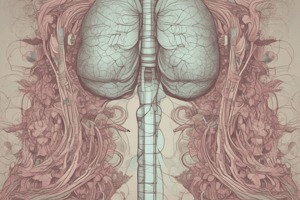Podcast
Questions and Answers
Bromhexine is an example of a bronchodilator.
Bromhexine is an example of a bronchodilator.
False (B)
Mometasone is a type of mucolytic drug.
Mometasone is a type of mucolytic drug.
False (B)
Acetylcysteine is used to relieve bronchospasms.
Acetylcysteine is used to relieve bronchospasms.
False (B)
Salbutamol is a long-acting β-receptor agonist.
Salbutamol is a long-acting β-receptor agonist.
Xanthine derivatives are used to dilate airways and increase airflow.
Xanthine derivatives are used to dilate airways and increase airflow.
Leukotriene antagonists are used to treat COPD.
Leukotriene antagonists are used to treat COPD.
Ambroxol is a type of corticosteroid.
Ambroxol is a type of corticosteroid.
Corticosteroids are used to relieve bronchospasms.
Corticosteroids are used to relieve bronchospasms.
Dextromethorphan is a non-opioid expectorant.
Dextromethorphan is a non-opioid expectorant.
Antihistamines are used to relieve cold symptoms, such as sneezing and runny nose.
Antihistamines are used to relieve cold symptoms, such as sneezing and runny nose.
Guaifenesin is a type of antitussive.
Guaifenesin is a type of antitussive.
Phenylephrine is a type of decongestant that reduces congestion of nasal passages and increases drainage of sinuses.
Phenylephrine is a type of decongestant that reduces congestion of nasal passages and increases drainage of sinuses.
Codeine is an opioid antitussive that is commonly used in children.
Codeine is an opioid antitussive that is commonly used in children.
Loratadine is a type of decongestant.
Loratadine is a type of decongestant.
Expectorants are used to relieve productive coughs.
Expectorants are used to relieve productive coughs.
Oxymetazoline is a type of antihistamine.
Oxymetazoline is a type of antihistamine.
Antitussive drugs are used to treat productive cough and help clear the airway.
Antitussive drugs are used to treat productive cough and help clear the airway.
Mucolytics are drugs used to reduce nasal congestion.
Mucolytics are drugs used to reduce nasal congestion.
Expectorants are used to stop or reduce coughing.
Expectorants are used to stop or reduce coughing.
Decongestants are used to treat viral infections.
Decongestants are used to treat viral infections.
Antihistamines are used to treat allergic reactions.
Antihistamines are used to treat allergic reactions.
Cough suppressants are used to treat productive cough.
Cough suppressants are used to treat productive cough.
Non-productive cough is associated with bacterial infections.
Non-productive cough is associated with bacterial infections.
Mucolytics are used to treat lower respiratory tract disorders.
Mucolytics are used to treat lower respiratory tract disorders.
Study Notes
Upper Respiratory Tract Disorders
- Inflammatory disorders: rhinitis, sinusitis, tonsillitis, and common cold
- Viral or bacterial infections cause excessive mucus production and irritation of nasal mucosa
- Symptoms: sneeze and cough reflex, nasal congestion, and mucosal irritation
Cough Physiology
- Cough is a physiological and protective reflex to clear airways
- Can be a sign of disease, such as infections, asthma, or pulmonary tumors
- Two types of cough:
- Non-productive cough: viral infection, dry cough, no excessive mucus production, can be treated with cough suppressants
- Productive cough: bacterial infections, excessive mucus production, coughing helps clear airways, cough suppression is harmful
Antitussive Drugs
- Used to stop or reduce coughing, suppress cough reflex by direct action on the CNS
- Only used for non-productive cough, not for productive cough
- Examples: Corticosteroids (Beclomethasone, Mometasone, Flunisolide)
Mucolytic Drugs
- Reduce viscosity of sputum and respiratory secretions, making it easier to cough up
- Examples: Bromhexine, Ambroxol, Acetylcysteine, Carbocysteine
Lower Respiratory Tract Disorders
- COPD: progressive lung disease causing breathing problems, associated with lung inflammation
- Asthma: episodic obstruction of respiratory passage, characterized by wheezing, shortness of breath, and difficulty breathing
Antiasthma Drugs
- Bronchodilators:
- β-receptor agonists: Salbutamol, Terbutaline, Salmeterol, Formoterol
- Xanthine derivatives: Theophylline, Aminophylline
- Leukotriene antagonists: block leukotriene effects, preventing bronchospasm, inflammation, and mucus secretion
Expectorants
- Help remove mucus by stimulating secretory glands, loosening and thinning sputum
- Used in non-productive and chronic cough
- Examples: Guaifenesin, Potassium iodide
Histamines and Antihistamines
- Histamine: released in response to allergic reactions, causing histamine effects (congestion, runny nose, watery eyes)
- Antihistamines: bind to H1 histamine receptors, preventing histamine effects
- Used to relieve cold symptoms, perennial or seasonal allergic rhinitis, allergic reactions
- Examples: Diphenhydramine, Fexofenadine, Loratadine
Nasal Congestion and Decongestants
- Nasal congestion: dilation of nasal blood vessels, transudation of fluid into tissue spaces, and swelling of nasal cavity
- Causes: allergy, infection, inflammation
- Decongestants:
- Adrenergics: stimulate α-adrenergic receptors, causing vasoconstriction
- Examples: Naphazoline, Oxymetazoline, Phenylephrine
Studying That Suits You
Use AI to generate personalized quizzes and flashcards to suit your learning preferences.
Description
This quiz covers the types of antitussives, including opioids and non-opioids, and expectorants that help remove mucus from the respiratory tract. Learn about their mechanisms and uses in treating coughs.




